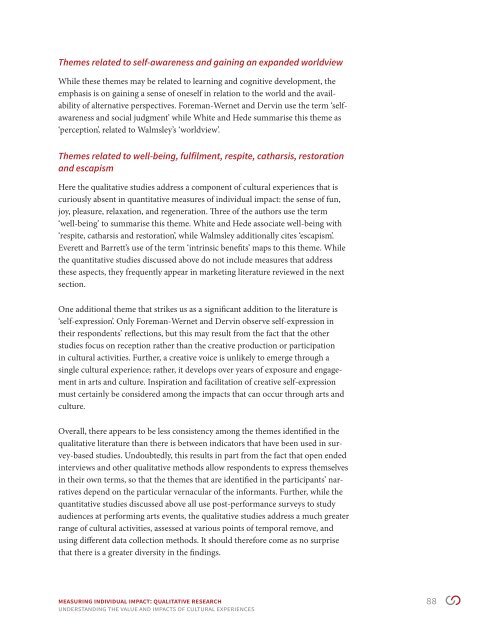aceUVi
aceUVi
aceUVi
Create successful ePaper yourself
Turn your PDF publications into a flip-book with our unique Google optimized e-Paper software.
Themes related to self-awareness and gaining an expanded worldview<br />
While these themes may be related to learning and cognitive development, the<br />
emphasis is on gaining a sense of oneself in relation to the world and the availability<br />
of alternative perspectives. Foreman-Wernet and Dervin use the term ‘selfawareness<br />
and social judgment’ while White and Hede summarise this theme as<br />
‘perception’, related to Walmsley’s ‘worldview’.<br />
Themes related to well-being, fulfilment, respite, catharsis, restoration<br />
and escapism<br />
Here the qualitative studies address a component of cultural experiences that is<br />
curiously absent in quantitative measures of individual impact: the sense of fun,<br />
joy, pleasure, relaxation, and regeneration. Three of the authors use the term<br />
‘well-being’ to summarise this theme. White and Hede associate well-being with<br />
‘respite, catharsis and restoration’, while Walmsley additionally cites ‘escapism’.<br />
Everett and Barrett’s use of the term ‘intrinsic benefits’ maps to this theme. While<br />
the quantitative studies discussed above do not include measures that address<br />
these aspects, they frequently appear in marketing literature reviewed in the next<br />
section.<br />
One additional theme that strikes us as a significant addition to the literature is<br />
‘self-expression’. Only Foreman-Wernet and Dervin observe self-expression in<br />
their respondents’ reflections, but this may result from the fact that the other<br />
studies focus on reception rather than the creative production or participation<br />
in cultural activities. Further, a creative voice is unlikely to emerge through a<br />
single cultural experience; rather, it develops over years of exposure and engagement<br />
in arts and culture. Inspiration and facilitation of creative self-expression<br />
must certainly be considered among the impacts that can occur through arts and<br />
culture.<br />
Overall, there appears to be less consistency among the themes identified in the<br />
qualitative literature than there is between indicators that have been used in survey-based<br />
studies. Undoubtedly, this results in part from the fact that open ended<br />
interviews and other qualitative methods allow respondents to express themselves<br />
in their own terms, so that the themes that are identified in the participants’ narratives<br />
depend on the particular vernacular of the informants. Further, while the<br />
quantitative studies discussed above all use post-performance surveys to study<br />
audiences at performing arts events, the qualitative studies address a much greater<br />
range of cultural activities, assessed at various points of temporal remove, and<br />
using different data collection methods. It should therefore come as no surprise<br />
that there is a greater diversity in the findings.<br />
Measuring Individual Impact: Qualitative Research 88<br />
UNDERSTANDING the value and impacts of cultural experiences


